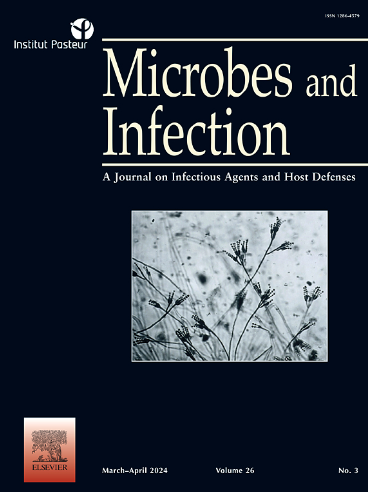NLRP1B allele 2 does not respond to Val-boro-Pro (VbP) in intestinal epithelial cells
IF 2.6
4区 医学
Q3 IMMUNOLOGY
引用次数: 0
Abstract
The intestinal mucosa must balance tolerance to commensal microbes and luminal antigens with rapid detection of enteric pathogens in order to maintain homeostasis. This balance is facilitated through the regulation of epithelial layer integrity by innate immune receptors. Certain NOD-like receptors (NLRs) expressed in intestinal epithelial cells, including NLRC4 and NLRP9B, form inflammasomes that protect against pathogens by activating caspase-1 to cause extrusion of infected cells. NLRP1B is a murine NLR encoded by five alleles of a highly polymorphic gene homologous to human NLRP1. NLRP1B forms inflammasomes in response to a variety of pathogens that cause intestinal infections, but it has almost exclusively been studied in immune cells and has not been characterized in cells of the intestinal epithelium. Here, we show that Nlrp1b allele 2 is expressed in ileal and colonic organoids derived for C57BL/6J mice, while the related gene Nlrp1a was not expressed. Nlrp1b was upregulated by interleukin-13 in organoids and by the protozoan Tritrichomonas muris in vivo, suggesting that NLRP1B may be involved in defense against enteric parasites. Surprisingly, while Val-boro-Pro (VbP) activated C57BL/6J-derived bone marrow-derived macrophages, which expressed both Nlrp1a and Nlrp1b, it did not activate intestinal organoids of the same genotype. We furthermore did not detect Nlrp1b in organoids derived from Balb/cJ mice, which express a different allele than the one expressed in C57BL/6J mice. Together, our results suggest that NLRP1B may have an allele-dependent function in murine IECs whose regulation is distinct from that of macrophages, and that the response to VbP might be exclusively driven by NLRP1A in C57BL/6J mice.
肠上皮细胞中表达的 NLRP1B 对 Val-boro-Pro 的激活具有耐受性。
肠粘膜必须在对共生微生物和管腔抗原的耐受性与对肠道病原体的快速检测之间保持平衡,以维持体内平衡。这种平衡是通过先天性免疫受体对上皮细胞层完整性的调节来实现的。在肠上皮细胞中表达的某些 NOD 样受体(NLRs),包括 NLRC4 和 NLRP9B,可形成炎性体,通过激活 caspase-1 导致受感染细胞被挤出,从而抵御病原体。NLRP1B 是一种鼠类 NLR,由与人类 NLRP1 同源的高度多态基因的五个等位基因编码。NLRP1B 在应对各种导致肠道感染的病原体时形成炎性体,但它几乎只在免疫细胞中被研究过,在肠上皮细胞中还没有被描述过。在这里,我们发现 Nlrp1b 在 C57BL/6J 小鼠的回肠和结肠器官组织中表达。Nlrp1b在器官组织中受白细胞介素-13的影响以及在体内受原生动物鼠疫单胞菌的影响而上调,这表明NLRP1B可能参与了对肠道寄生虫的防御。令人惊讶的是,Val-boro-Pro(VbP)能激活骨髓巨噬细胞中的 NLRP1B,但却不能激活器官组织中的 NLRP1B。此外,我们在 Balb/cJ 小鼠的器官组织中也没有检测到 Nlrp1b,因为 Balb/cJ 小鼠表达的等位基因与 C57BL/6J 小鼠表达的等位基因不同。总之,我们的研究结果表明,NLRP1B 在小鼠 IEC 中可能具有等位基因依赖性功能,其调控方式与巨噬细胞不同。
本文章由计算机程序翻译,如有差异,请以英文原文为准。
求助全文
约1分钟内获得全文
求助全文
来源期刊

Microbes and Infection
医学-病毒学
CiteScore
12.60
自引率
1.70%
发文量
90
审稿时长
40 days
期刊介绍:
Microbes and Infection publishes 10 peer-reviewed issues per year in all fields of infection and immunity, covering the different levels of host-microbe interactions, and in particular:
the molecular biology and cell biology of the crosstalk between hosts (human and model organisms) and microbes (viruses, bacteria, parasites and fungi), including molecular virulence and evasion mechanisms.
the immune response to infection, including pathogenesis and host susceptibility.
emerging human infectious diseases.
systems immunology.
molecular epidemiology/genetics of host pathogen interactions.
microbiota and host "interactions".
vaccine development, including novel strategies and adjuvants.
Clinical studies, accounts of clinical trials and biomarker studies in infectious diseases are within the scope of the journal.
Microbes and Infection publishes articles on human pathogens or pathogens of model systems. However, articles on other microbes can be published if they contribute to our understanding of basic mechanisms of host-pathogen interactions. Purely descriptive and preliminary studies are discouraged.
 求助内容:
求助内容: 应助结果提醒方式:
应助结果提醒方式:


